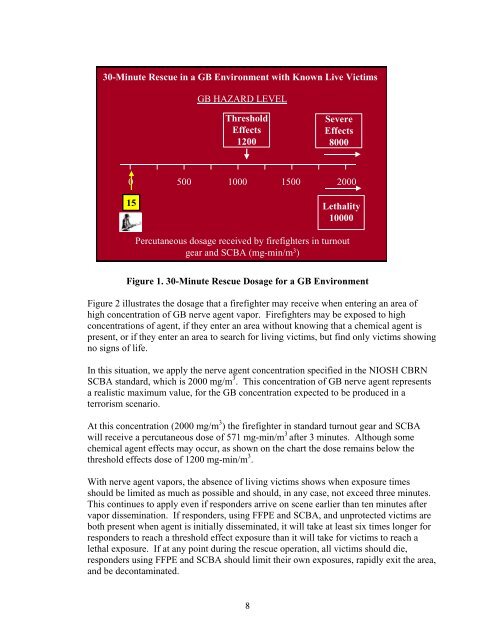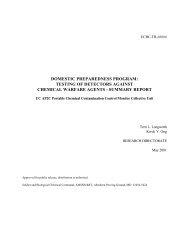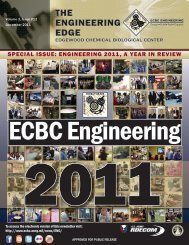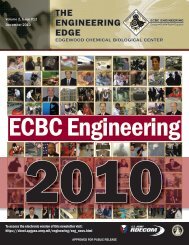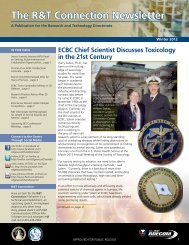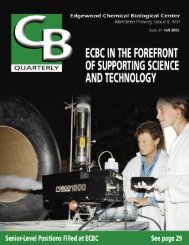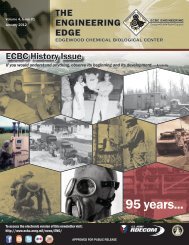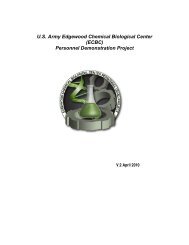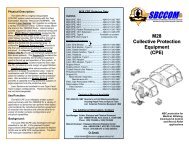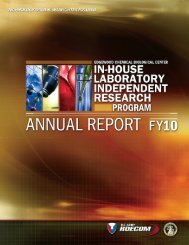(FFPE) with Self-Contained Breathing Apparatus (SCBA) for Rescue
(FFPE) with Self-Contained Breathing Apparatus (SCBA) for Rescue
(FFPE) with Self-Contained Breathing Apparatus (SCBA) for Rescue
You also want an ePaper? Increase the reach of your titles
YUMPU automatically turns print PDFs into web optimized ePapers that Google loves.
30-Minute <strong>Rescue</strong> in a GB Environment <strong>with</strong> Known Live Victims<br />
GB HAZARD LEVEL<br />
Threshold<br />
Effects<br />
1200<br />
Severe<br />
Effects<br />
8000<br />
0 500 1000 1500 2000<br />
15<br />
Lethality<br />
10000<br />
Percutaneous dosage received by firefighters in turnout<br />
gear and <strong>SCBA</strong> (mg-min/m 3 )<br />
Figure 1. 30-Minute <strong>Rescue</strong> Dosage <strong>for</strong> a GB Environment<br />
Figure 2 illustrates the dosage that a firefighter may receive when entering an area of<br />
high concentration of GB nerve agent vapor. Firefighters may be exposed to high<br />
concentrations of agent, if they enter an area <strong>with</strong>out knowing that a chemical agent is<br />
present, or if they enter an area to search <strong>for</strong> living victims, but find only victims showing<br />
no signs of life.<br />
In this situation, we apply the nerve agent concentration specified in the NIOSH CBRN<br />
<strong>SCBA</strong> standard, which is 2000 mg/m 3 . This concentration of GB nerve agent represents<br />
a realistic maximum value, <strong>for</strong> the GB concentration expected to be produced in a<br />
terrorism scenario.<br />
At this concentration (2000 mg/m 3 ) the firefighter in standard turnout gear and <strong>SCBA</strong><br />
will receive a percutaneous dose of 571 mg-min/m 3 after 3 minutes. Although some<br />
chemical agent effects may occur, as shown on the chart the dose remains below the<br />
threshold effects dose of 1200 mg-min/m 3 .<br />
With nerve agent vapors, the absence of living victims shows when exposure times<br />
should be limited as much as possible and should, in any case, not exceed three minutes.<br />
This continues to apply even if responders arrive on scene earlier than ten minutes after<br />
vapor dissemination. If responders, using <strong>FFPE</strong> and <strong>SCBA</strong>, and unprotected victims are<br />
both present when agent is initially disseminated, it will take at least six times longer <strong>for</strong><br />
responders to reach a threshold effect exposure than it will take <strong>for</strong> victims to reach a<br />
lethal exposure. If at any point during the rescue operation, all victims should die,<br />
responders using <strong>FFPE</strong> and <strong>SCBA</strong> should limit their own exposures, rapidly exit the area,<br />
and be decontaminated.<br />
8


